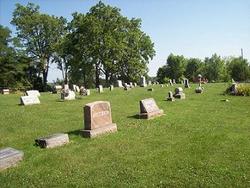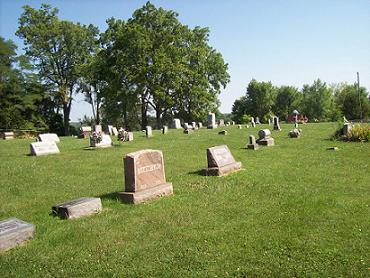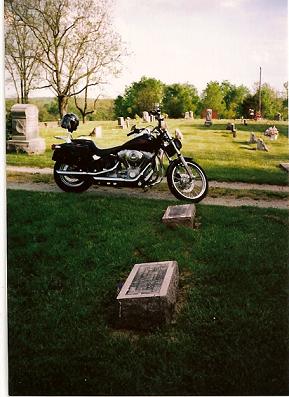Tribute by Roy Wheeler Brown, Indianapolis Star Magazine, Readers Corner; Indianapolis, IN, 1972: Out of about five million residents of Indiana how many can remember the name of the first Hoosier killed in the Korean War? Who cares? I can, and I do. He was 23-year-old Corporal Richard E. Millis and was one of my best friends.
Dick was born in Greensboro where he lived for several years. His parents moved to Kennard where I lived and where we both attended Kennard High School. He was a tall, lanky guy with very dark hair and blue eyes. He was highly intelligent with a razor-sharp wit and sense of humor. One of the outstanding features of Dick's personality to those who knew him well was his restless, devil-may-care and sometimes reckless attitude.
I remember the days that Dick, other boys, and I would go bicycle riding for hours and hours. We invented a game we played on our bikes. We chose one boy to be the leader and discovered that the biggest challenge and most exciting thing to do was to fight for second place, not first place, as the leader led us up and down hills, through narrow alleys and around all sorts of difficult obstacles. Many a spoke and fender was bent out of shape during those hazardous days, and many a boy was cut and bruised but it was so much fun! During all of this Dick was the most daring of all of us, and no risk was too great for him to take.
As we grew older Dick's recklessness was evident as an auto driver. He was an excellent driver but delighted in high speeds and racing other cars down the highway. Later he exhibited the same desire for speed thrills on a motorcycle he bought. I took many a hairy ride, with Dick seeing how close we could cut-in on a car's left front fender as we roared by on the big Harley-Davidson.
World War II saw me enter the U.S. Navy, and Dick went into the Army Infantry. He fought in the vicious battle to recapture the Philippine Islands where he contracted malaria.
After the war, Dick got a job at Delco-Remy in Anderson and told me many times how much he hated the dull routine of factory work and civilian life in general. I also saw him many times suffering from recurrences of malaria.
His restlessness became almost bitterness which we both felt as civilians. It was an undefinable feeling of disgusted impatience with peacetime life and the attitude of the public.
Since Dick and I had been interested in photography since we were young boys and had spent many pleasant hours developing and printing photos in his uncle's darkroom facilities, he decided to make photography a career. It sounded ex-citing and profitable so Dick enrolled in the Baltimore Institute of Photography from which he was graduated. He proceeded to purchase a camera and hundreds of dollars of equipment. It looked as though he had found his niche in life.
Somehow he again became itchy and nervously moody about life. He then decided to re-enlist in the U.S. Army and begged me to go with him. However, I had just had a bout with pneumonia, contracted on a Michigan fishing trip and told him I didn't think I could pass the physical exam until I had recuperated for a longer period of time.
Consequently, Dick enlisted alone and was sent to an army photography school. Later, while on furlough he indicated to me that he was very happy with army life and again tried to persuade me to enlist. Somehow I just couldn't bring myself to do that, and Dick went off to Japan and became a member of General MacArthur's staff as a photographer. His duties there seemed to be very satisfying and evidently there was enough excitement about it to fulfill the mysterious, searching, inner quality which was his life-long trait.
In June 25, 1950, the North Korean Communist troops invaded South Korea, and Dick immediately began making round trip flights from Japan to Korea, photographing the hectic hell of those first few days of the war.
A few days later we heard the terrible news that he was missing-in-action, and within hours that report was altered to the heartbreaking verification that my friend Dick Millis was dead - killed-in-action for his beloved country. His search for excitement was ended forever.
Dick's body was brought back for burial where it now rests in a lonely, lovely little cemetery south of Greensboro where I visit to pay my deepest respects and admiration once a year.
Cpl. Richard E. Millis was voted Hoosier of the Year for 1950 by a panel of judges selected by an Indianapolis newspaper, an honor he justly deserved and for which he would have been deeply proud. I'll always remember my friend Dick Millis and will forever remember what he did for our nation as the first Hoosier to die in the Korean War.
Tribute by Roy Wheeler Brown, Indianapolis Star Magazine, Readers Corner; Indianapolis, IN, 1972: Out of about five million residents of Indiana how many can remember the name of the first Hoosier killed in the Korean War? Who cares? I can, and I do. He was 23-year-old Corporal Richard E. Millis and was one of my best friends.
Dick was born in Greensboro where he lived for several years. His parents moved to Kennard where I lived and where we both attended Kennard High School. He was a tall, lanky guy with very dark hair and blue eyes. He was highly intelligent with a razor-sharp wit and sense of humor. One of the outstanding features of Dick's personality to those who knew him well was his restless, devil-may-care and sometimes reckless attitude.
I remember the days that Dick, other boys, and I would go bicycle riding for hours and hours. We invented a game we played on our bikes. We chose one boy to be the leader and discovered that the biggest challenge and most exciting thing to do was to fight for second place, not first place, as the leader led us up and down hills, through narrow alleys and around all sorts of difficult obstacles. Many a spoke and fender was bent out of shape during those hazardous days, and many a boy was cut and bruised but it was so much fun! During all of this Dick was the most daring of all of us, and no risk was too great for him to take.
As we grew older Dick's recklessness was evident as an auto driver. He was an excellent driver but delighted in high speeds and racing other cars down the highway. Later he exhibited the same desire for speed thrills on a motorcycle he bought. I took many a hairy ride, with Dick seeing how close we could cut-in on a car's left front fender as we roared by on the big Harley-Davidson.
World War II saw me enter the U.S. Navy, and Dick went into the Army Infantry. He fought in the vicious battle to recapture the Philippine Islands where he contracted malaria.
After the war, Dick got a job at Delco-Remy in Anderson and told me many times how much he hated the dull routine of factory work and civilian life in general. I also saw him many times suffering from recurrences of malaria.
His restlessness became almost bitterness which we both felt as civilians. It was an undefinable feeling of disgusted impatience with peacetime life and the attitude of the public.
Since Dick and I had been interested in photography since we were young boys and had spent many pleasant hours developing and printing photos in his uncle's darkroom facilities, he decided to make photography a career. It sounded ex-citing and profitable so Dick enrolled in the Baltimore Institute of Photography from which he was graduated. He proceeded to purchase a camera and hundreds of dollars of equipment. It looked as though he had found his niche in life.
Somehow he again became itchy and nervously moody about life. He then decided to re-enlist in the U.S. Army and begged me to go with him. However, I had just had a bout with pneumonia, contracted on a Michigan fishing trip and told him I didn't think I could pass the physical exam until I had recuperated for a longer period of time.
Consequently, Dick enlisted alone and was sent to an army photography school. Later, while on furlough he indicated to me that he was very happy with army life and again tried to persuade me to enlist. Somehow I just couldn't bring myself to do that, and Dick went off to Japan and became a member of General MacArthur's staff as a photographer. His duties there seemed to be very satisfying and evidently there was enough excitement about it to fulfill the mysterious, searching, inner quality which was his life-long trait.
In June 25, 1950, the North Korean Communist troops invaded South Korea, and Dick immediately began making round trip flights from Japan to Korea, photographing the hectic hell of those first few days of the war.
A few days later we heard the terrible news that he was missing-in-action, and within hours that report was altered to the heartbreaking verification that my friend Dick Millis was dead - killed-in-action for his beloved country. His search for excitement was ended forever.
Dick's body was brought back for burial where it now rests in a lonely, lovely little cemetery south of Greensboro where I visit to pay my deepest respects and admiration once a year.
Cpl. Richard E. Millis was voted Hoosier of the Year for 1950 by a panel of judges selected by an Indianapolis newspaper, an honor he justly deserved and for which he would have been deeply proud. I'll always remember my friend Dick Millis and will forever remember what he did for our nation as the first Hoosier to die in the Korean War.
Gravesite Details
For a complete history of this pioneer cemetery go to link, http://www.hcgs.net/hick.html







